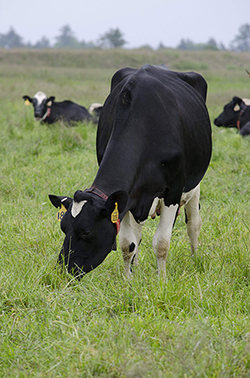The drought that affected much of the United States last summer will likely have an impact on pastureland this growing season. Rhonda Gildersleeve, Grazing Specialist from the University of Wisconsin-Extension, shared some guidelines for caring for pastures after a drought year at the ‘Managed Grazing in Central Wisconsin' workshop last week.
 First, you want to assess your pastures to determine which ones need special attention. This includes a close look at soil fertility. Healthy soils are better able to tolerate suboptimal growing conditions like drought. In general, pastures should be soil tested every three to four years to maintain or improve soil nutrient levels.
First, you want to assess your pastures to determine which ones need special attention. This includes a close look at soil fertility. Healthy soils are better able to tolerate suboptimal growing conditions like drought. In general, pastures should be soil tested every three to four years to maintain or improve soil nutrient levels.
Adding legumes can make significant improvements in yield, quality and palatability in a pasture, as well as adding nitrogen to associated grasses. Aim for 30 to 40 percent legume in the mix. A consistent legume plan needs to be developed to maintain or improve the percentage and productivity of the legumes.
Weed competition may increase in drought-damaged pastures. Pastures that are grazed hard are likely to have more germination in all weed classes (annual, biennial and perennial weeds). Scout pastures early in the season to determine a plan for weed control.
Special care should be taken to manage grazing after a drought year. One recommendation is to subdivide larger pastures, which provides more rest time for each pasture. You may consider turning an old pasture that needs to be reseeded into a ‘sacrifice' pasture, keeping animals there for an extended period of time and feeding hay while other pastures grow.
Lastly, although both farmers and cows get anxious, you also should avoid turning cattle out to pasture too early. When is a pasture ready for grazing? Gildersleeve said that a pasture is ready when it has enough feed to satisfy the animals' dry matter intakes and the plant is physiologically capable of regrowth after defoliation. In the spring, that is typically when plants are 10 to 12 inches tall. In the fall, it is about 8 inches.
Also speaking at the conference was dairy farmer Dan Vosberg of Vosberg Valley View Farm, Inc., South Wayne, Wisc., who milks 200 cows in a parlor and grazing set-up. He shared his goals for the future to combat high feed, land and rent prices.
 First, you want to assess your pastures to determine which ones need special attention. This includes a close look at soil fertility. Healthy soils are better able to tolerate suboptimal growing conditions like drought. In general, pastures should be soil tested every three to four years to maintain or improve soil nutrient levels.
First, you want to assess your pastures to determine which ones need special attention. This includes a close look at soil fertility. Healthy soils are better able to tolerate suboptimal growing conditions like drought. In general, pastures should be soil tested every three to four years to maintain or improve soil nutrient levels. Adding legumes can make significant improvements in yield, quality and palatability in a pasture, as well as adding nitrogen to associated grasses. Aim for 30 to 40 percent legume in the mix. A consistent legume plan needs to be developed to maintain or improve the percentage and productivity of the legumes.
Weed competition may increase in drought-damaged pastures. Pastures that are grazed hard are likely to have more germination in all weed classes (annual, biennial and perennial weeds). Scout pastures early in the season to determine a plan for weed control.
Special care should be taken to manage grazing after a drought year. One recommendation is to subdivide larger pastures, which provides more rest time for each pasture. You may consider turning an old pasture that needs to be reseeded into a ‘sacrifice' pasture, keeping animals there for an extended period of time and feeding hay while other pastures grow.
Lastly, although both farmers and cows get anxious, you also should avoid turning cattle out to pasture too early. When is a pasture ready for grazing? Gildersleeve said that a pasture is ready when it has enough feed to satisfy the animals' dry matter intakes and the plant is physiologically capable of regrowth after defoliation. In the spring, that is typically when plants are 10 to 12 inches tall. In the fall, it is about 8 inches.
Also speaking at the conference was dairy farmer Dan Vosberg of Vosberg Valley View Farm, Inc., South Wayne, Wisc., who milks 200 cows in a parlor and grazing set-up. He shared his goals for the future to combat high feed, land and rent prices.
- Grow more feed on the current land base (including double cropping).
- Improve pastures to grow better feed for the dairy herd.
- Rent nontillable land when it is available to utilize for more pasture.
- Waste less feed, both in storage structures and preventing overfeeding.
- Utilize a Total Mixed Ration (TMR) to incorporate some less palatable feeds into the ration.
- Work to produce more milk per cow.









